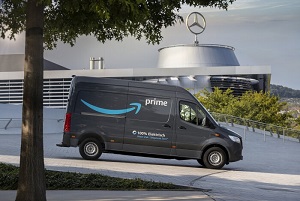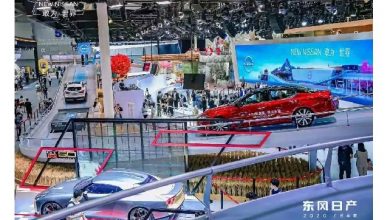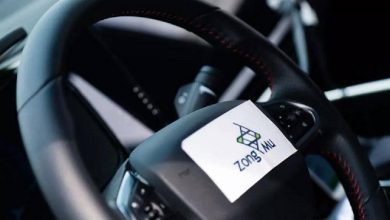Mercedes-Benz and Amazon jointly advocate climate protection and bring locally emission-free mobility to the streets

Mercedes-Benz AG joins “The Climate Pledge” – a commitment co-founded by Amazon and Global Optimism
- Objective of the commitment: carbon neutrality of all signatory companies ten years before the target set in the Paris Agreement
- Mercedes-Benz supports this goal with “Ambition2039”
In 2019, Amazon and Global Optimism founded “The Climate Pledge”. The initiative has set itself the goal of contributing to achieving the goals of the Paris Agreement ten years earlier than it is intended there, i.e. already in 2040. The signing companies agree to:
- Measure and report greenhouse gas emissions on a regular basis.
- Implement decarbonisation strategies in line with the Paris Agreement through real business change and innovation, including efficiency improvements, renewable energy, materials reductions, and other carbon emission elimination strategies.
- Take actions to neutralize any remaining emissions with additional, quantifiable, real, permanent and socially-beneficial offsets to achieve net zero annual carbon emissions by 2040.
Mercedes-Benz has now joined the Climate Pledge and supports the initiative with its own Ambition 2039 initiative.
Ola Källenius, Chairman of the Board of Management of Daimler AG and Mercedes-Benz AG:
“At Mercedes-Benz, we have set ourselves the ambitious target to make the transformation of mobility a success story. By joining ‘The Climate Pledge’ we are building on our goal to consistently pursue emission-free mobility and sustainable vehicle production. We stand with Amazon, Global Optimism and the other signatories of The Climate Pledge, in a commitment to being net zero carbon by 2040 – ten years ahead of The Paris Agreement. I am pleased that we will be able to gain even more momentum on our sustainability offensive with this step.”
“We welcome the bold leadership demonstrated by Mercedes-Benz by signing up to The Climate Pledge and committing to ambitious action to address climate change,” Jeff Bezos, Amazon founder and CEO. “We need continued innovation and partnership from auto manufacturers like Mercedes-Benz to decarbonize the transportation sector and tackle the climate crisis. The addition of 1,800 electric delivery vehicles is another step in our journey to building the most sustainable transportation fleet in the world, and we will be moving fast to get these vans on the road this year.”
One year ago, Mercedes-Benz presented its “Ambition2039”, a roadmap to CO2-neutral mobility. With that, the company is looking at the entire value chain, from development to the supplier network, its own production to the electrification of products and beyond to renewable energies for the use phase of electric vehicles. With its goal to have a CO2-neutral fleet of new cars in less than 20 years, the company is making an important contribution to slowing down climate change. The company is already making good progress in this direction: by the end of this year, the vehicle portfolio will comprise five fully electric models and more than 20 plug-in hybrids.
Vehicle production has a crucial role to play on the road to zero-emission mobility. From 2022, Mercedes-Benz’s own passenger car and vans plants will be CO2-neutral. This comprises more than 30 car and van plants worldwide. One important component of this is battery production, which will also be CO2-neutral worldwide from 2022.
Amazon order of more than 1,800 electric vehicles from Mercedes-Benz Vans
- Amazon places the largest order of electric vehicles for Mercedes-Benz to date
- The electric vehicles from this order will begin making deliveries to customers in Europe in 2020
Mercedes-Benz Vans and Amazon announce the largest order for Mercedes-Benz electric vehicles to date: more than 1,800 battery-electric eVito and eSprinter from Mercedes-Benz Vans will be delivered to Amazon starting this year to be used across Europe. The order includes around 600 medium-sized eVito and more than 1,200 vehicles of the large-size van eSprinter.
“I am delighted that we are further intensifying our long-standing partnership with Amazon and working together on the battery-electric future of transportation,” says Marcus Breitschwerdt, Head of Mercedes-Benz Vans. “With the eVito and the eSprinter, we have electric vehicles in our portfolio, which are ideally suited for the requirements of the courier-, express- and parcel-service industry for goods delivery on the so-called ‘last mile’ in terms of their equipment and range. They show that local emission-free driving, convincing performance, comfort and low operating costs can be combined perfectly.”
Electrification of traffic on the so-called “last mile” is progressing. In particular, the courier-, express- and parcel-services industry (CEP) is a great driver here. The growing online trade and flexible delivery services in recent years not only brought an increase in inner-city traffic, but also lead to increasing local emission-free drives in urbanized areas. In addition, the preconditions are good for the use of electric vans in the CEP industry: routes can be planned well in advance, are manageable in length and distance and normally there are larger areas near distribution centres of the logistics service providers, which are suitable for the commissioning of corresponding charging infrastructure.
Mercedes-Benz Vans and Amazon: since 2018 in cooperation for modern mobility
Mercedes-Benz Vans and Amazon Logistics Germany recognized the potential of a collaboration in the field of electric mobility early on, and put into operation in 2018. Together with the Mercedes-Benz contract partner Fahrzeug-Werke LUEG AG and other partners equipped the Amazon distribution centre in the North Rhine-Westphalia city of Bochum with charging infrastructure. In July 2020 Europe’s largest connected charging infrastructure of about 340 charging points at the Amazon Delivery Station in Essen was established by LUEG basecamp GmbH. The companies have been cooperating in many ways also on an international basis.
Electric mobility from Mercedes-Benz Vans: locally emission-free specialists for goods and passenger transport
With the eVito in 2018 and the eSprinter in 2019, Mercedes-Benz Vans has taken on an important role in the segment for locally emission-free cargo transport in urban areas. The positioning of the battery in the subside of the vehicles creates a generous interior without any restrictions regarding the loading volume, which is particularly important for delivery services. With the new Mercedes-Benz eVito Tourer (power consumption combined: 26.2 kWh/100km; CO2-Emissionen combined: 0 g/km)[1] available now with high-torque electric motor and 421 kilometres range[2], [3] as well as the fully electric EQV (combined power consumption: 26.4-26.3 kWh/100km; CO2-Emissionen combined: 0g/km)1, electric passenger transport has also grown to meet electric mobility requirements: as a hotel shuttle, as a large taxi or vehicle for ride sharing services. The Citan will also be available in its next generation with battery-electric drive and thus round off the electric product portfolio of Mercedes-Benz Vans.
Mercedes-Benz eSprinter: locally emission-free and with large load compartment
The eSprinter for Amazon are panel vans with a permissible gross vehicle weight of 3,500 kilograms in high roof design. The electric engine drives the front wheels and, like the diesel starter unit, delivers max. 85 kW with a torque of up to 295 Nm. With the eSprinter, the customer can choose between two battery capacities, depending on whether a greater range or a higher payload is prioritized. The vehicles produced for Amazon come with the larger battery, namely with a usable battery capacity of 47 kWh (installed: 55 kWh), have a range of 168 km2,3 and a maximum payload of 891 kilograms. For flexibility, the integrated quick charging function also ensures the battery can be recharged from 10 percent to 80 percent within approx. 25 minutes[4].
The load capacity of 11 m³ can be used without restriction because the batteries are installed under the loading floor. The eSprinter for Amazon includes state-of-the-art safety features like electrical parking brake, active brake assist, reverse camera, blind spot assist, crosswind assist and ATTENTION ASSIST.
With the eSprinter, the customer is also provided with an additional connectivity-capable electric vehicle as it has the installed connectivity module as standard. The advantages of the digitized eVan management can thus also be used for the eSprinter. The Mercedes PRO connect service “Remote-controlled charging management”, provides important information about the charging of the eSprinter (charge level, end of charge). In addition, pre-entry climate control can be activated and the vehicle interior can be pleasantly tempered even before starting, without this being at the expense of the range. The eSprinter for Amazon is produced at the Mercedes-Benz plant in Düsseldorf.
Mercedes-Benz eVito: flexible in urban use
The natural environment of the eVito panel van are urban areas. The eVito is also ideal for locally emission-free transport on the last mile. The installed battery capacity of 35 kWh (installed 41 kWh) ensures a range of 150 to 184 kilometers2, 3. After six hours of charging, the full range is available again4. The battery-electric drive achieves max. 85 kW and achieves a torque of up to 295 Nm, tailor-made for urban use. The maximum speed can be configured when ordering depending on the application. If the eVito is mainly on the road in the inner city area – like the vans for Amazon – a maximum speed of 80 km/h protects the energy reserves and increases the range. Alternatively, a maximum speed of up to 120 km/h can be configured. The positioning of the battery in the substructure of the eVito creates a generous interior without restrictions with regard to the loading volume. In addition to the design as a panel van for goods transport, the eVito is also available as a Tourer (power consumption in combined test cycle 26.2 kWh/100km, CO2-Emissionen 0g/km)1, with a range of 421 kilometres2, 3 and quick charging function for passenger transport. The eVito is built as the Vito in the Mercedes-Benz Vitoria plant, Spain.
[1] The electrical consumption has been determined on the basis of Directive 692/2008/EC. The electrical consumption depends on the vehicle configuration.
[2] Range has been determined on the basis of Directive 692/2008/EC. Range depends on the vehicle configuration.
[3] The actual range is also dependent on the individual driving style, road and traffic conditions, the outside temperature and use of the air conditioning system/heating, and may differ.
[4] The duration of the battery charge depends on the charging infrastructure.






2 Comments